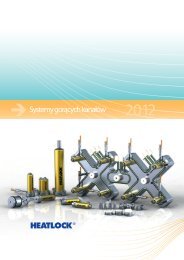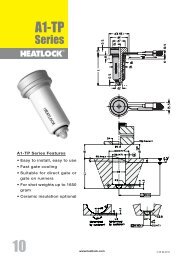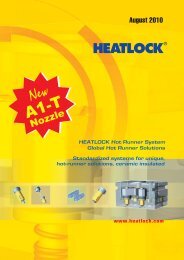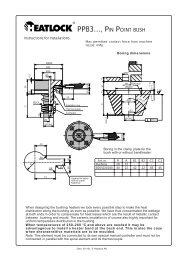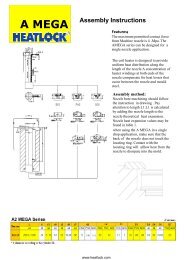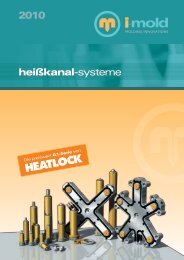Heatlock ESB2, Electric Sprue Bushing
Heatlock ESB2, Electric Sprue Bushing
Heatlock ESB2, Electric Sprue Bushing
Create successful ePaper yourself
Turn your PDF publications into a flip-book with our unique Google optimized e-Paper software.
This <strong>Heatlock</strong> series, below, is currently being replaced by the A1-series of nozzles.<br />
Before you design check availability, stock is gradually decreased.<br />
Spare parts will be available until at least end of 2007 (apart form NPT1 bodies)<br />
If the bushing is installed as shown in the diagram, all cables will be protected from plastic.<br />
If possible there shall be no contact between the back end of the bushing and the guide ring<br />
of the mould. Such contact will cause a heavy drop in temperature at the back end of the<br />
bushing. If the force at which the machine nozzle is pressed against the sprue bushing is<br />
greater then that caused by the injection force on the front area of the bushing, nothing is<br />
needed to keep bushing in place axially. The bushing can then be installed as shown in the<br />
diagram below.<br />
Max permitted contact force from<br />
S i n g l e - c a v i t y<br />
M u l t i - c a v i t y<br />
max 1.5<br />
Ø27<br />
9<br />
machine nozzle: 4Mp<br />
If a support is needed to fix the bushing<br />
axially the contact area must be as small<br />
as possible. The support area should<br />
preferably be as far as possible from the<br />
centre of the bushing. (Not on the<br />
flange.)<br />
Preferably an insulation ring part No.<br />
KE05002708 shall be placed between<br />
the back support and the surface of the<br />
bushing.<br />
Colour code for thermocouple wires.<br />
Black (red) wire + (Iron)<br />
White (blue) wire —.<br />
The connector sleeve of the thermocouple has a<br />
max. temperature resistance of 240 ϒC.<br />
Fitting of the front end of the bushing.<br />
A certain amount of cooling is needed at front end.<br />
It must remain at a temperature low enough to make the plastic solidify. Too much cooling will<br />
however cause the plastic in the flow channel to be highly viscous further into the bushing.<br />
The contact surface at the front end may therefore have to be trimmed depending on, for<br />
example, temperature wanted and cycle time.<br />
Length of contact at front end can usually be 2mm. For high temperature plastic and for long<br />
cycle time a shorter length may be needed (down to about 0,75mm). The fit at the front end in<br />
the mould also has an influence on the temperature at<br />
that area. A hard fit gives more cooling then a loose<br />
one.<br />
On injection moulding with fast-injecting materials it<br />
may sometimes be necessary to have a length of<br />
contact greater than 2 mm, so that sufficient heat can<br />
be carried away from the front face. This may mean<br />
increasing the temperature of the bushing during<br />
startup and reducing it in continuous operation.<br />
R=1<br />
An improved temperature zone separation in the front<br />
end of the bush will be achived if a groove is machined<br />
as sketch to the right. Usefull when moulding at high<br />
temperatures.<br />
3<br />
2<br />
ØD<br />
ØD(D+4)<br />
Appendix – 8<br />
Date: 050326, © <strong>Heatlock</strong> AB<br />
© LKM <strong>Heatlock</strong> Co Ltd




